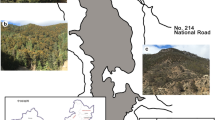Abstract
In long-term studies (21–30 years in the floodplain ecotype and 12 years in the ecotype of sandy terraces), the duration of the main phenological phases of the development of black alder (Alnus glutinosa Gaertn.) plants was determined. The influence of the edaphic factor is manifested in the dates of the termination and duration of individual phenophases. In the sandy-terrace ecotype, growth buds are laid 8 days earlier, the leaves fall 2 weeks earlier, and the period of shoot development is longer than 7 days. Statistically significant differences between the ecotypes (tf = 2.12–7.16 > t95 = 2.01–2.03) were revealed in the duration of flowering periods and leaf development. In each ecotype, the strongest dependence of the phenological phase duration was revealed under the combined influence of the heat and moisture conditions of the corresponding period (rx (yz) = 0.55–0.99). An identical phenological spectrum in the two studied ecotypes is observed in years with a 1.5- to 2.0-fold excess of the mean multiyear value of the hydrothermal coefficient.




Similar content being viewed by others
REFERENCES
Averina, I.A., Specific seasonal nature development in Kerzhinski Nature Reserve, Tr. Gos. Prirod. Zapoved. Kerzhenskii, 2001, vol. 1, pp. 347–388.
Beideman, I.N., Metodika izucheniya fenologii rastenii i rastitel’nykh soobshchestv (Analysis Methods of the Phenology of the Plants and Plant Communities), Novosibirsk: Nauka, 1974.
Bel’gard, A.L., Stepnoe lesovedenie (Steppe Forestry), Moscow: Lesnaya Prom-st, 1971.
Biomy Rossii, 2016. Karty dlya vysshikh uchebnykh zavedenii. Masshtab 1 : 7 500 000 (Biomes of Russia, 2016: Maps for Higher Educational Institutions, Scale 1 : 7 500 000), Ogureeva, G.N., Ed., Moscow: FOK-GIS, 2016.
Davidov, M.V., Ol’kha (The Alder), Moscow: Lesnaya Prom-st, 1979.
Fedotova, V.G. and Dostoevskaya, L.P., Phenological seasons in St. Petersburg, Biosfera, 2013, vol. 5, no. 4, pp. 436–449.
Gael’, A.G., Near-water sands in the drought regions and their afforestation by black alder and Scots pine, Lesovedenie, 1980, no. 3, pp. 81–95.
Ivanenko, B.I., Fenologiya drevesnykh i kustarnikovykh porod (Phenology of Wood and Shrubby Species), Moscow: Sel’khozizdat, 1962.
Kurnaev, S.F., Lesorastitel’noe raionirvanie SSSR (Forest Vegetation Zonation in the USSR), Moscow: Nauka, 1973.
Lakin, G.F., Biometriya: uchebnoe posobie dlya biologicheskikh spetsial’nostei vuzov (Biometry: Manual for Biological Specialties of Higher Educational Institutions), Moscow: Vysshaya Shkola, 1990, 4th ed.
Minin, A.A., Fenologiya Russkoi ravniny: materialy i obobshcheniya (Phenology of the Russian Plain: Materials and Summaries), Moscow: ABF, 2000.
Neishtadt, M.I., Istoriya lesov i paleogeografiya SSSR v golotsene (The History of Forests and Paleogeography of USSR in Holocene), Moscow: Akad. Nauk SSSR, 1957.
Order of the Ministry of Nature Resources and Ecology of Russian Federation no. 367 of August 18, 2014 “On approval of the list afforestation zones and forest regions of Russian Federation,” 2014. http://legalacts.ru/doc/ prikaz-minprirody-rossii-ot-18082014-n-367/. Accessed January 15, 2017.
OST (State Standard) 56-69-83: Sampling Areas Forest Management, Method of Bookmarks, Moscow: Izd. Standartov, 1983.
Selyaninov, G.T., Origin and dynamics of droughts, in Zasukhi v SSSR, ikh proiskhozhdenie, povtoryaemost’ i vliyanie na urozhai (Droughts in USSR: Origin, Frequency, and Impact on Crops), Leningrad: Gidrometeoizdat, 1958, pp. 5–30.
Shul’ts, G.E., Obshchaya fenologiya (General Phenology), Leningrad: Nauka, 1981.
Sokolov, S.Ya., Svyazeva, O.A., Kubli, V.A., Kamelin, R.V., Yakovlev, G.P., Grubov, V.I., Leonova, T.G., Vasil’ev, I.V., Gorbunova, N.V., Safronova, I.N., Ivanishvili, M.A., and Katenin, A.E., Arealy derev’ev i kustarnikov SSSR, Tom 1. Tissovye–Kirkazonovye (Ranges of Trees and Shrubs of USSR, Vol. 1: Taxaceae–Aristolochiaceae), Leningrad: Nauka, 1977.
Spravochnik po lesosemennomu delu (Handbook on Forest Growing from Seeds), Novosel’tseva, A.I., Ed., Moscow: Lesnaya Prom-st, 1978.
Turchin, T.Ya. and Turchina, T.A., Lesa stepnogo Pridon’ya (Forests of Steppe Don Region), Rostov-on-Don: Rostovsk. Gos. Univ., 2005.
Turchina, T.A., Forestation systems of the black alder (Alnus glutinosa Gaertn.) plantations in the steppe zone of European part of Russia, Doctoral (Agric.) Dissertation, Stanitsa Veshenskaya, 2016.
Weather archive at Kazan station, 2017. https://rp5.ru. Accessed January 15, 2017.
Zozulin, G.M., Lesa Nizhnego Dona (Forests of Lower Don River), Rostov-on-Don: Rostovsk. Gos. Univ., 1992.
Author information
Authors and Affiliations
Corresponding author
Ethics declarations
Conflict of interests. The author declares that she has no conflict of interest.
Statement on the welfare of animals. All applicable international, national, and/or institutional guidelines for the care and use of animals were followed.
Additional information
Translated by T. Borisova
Rights and permissions
About this article
Cite this article
Turchina, T.A. Phenospectrum of Black Alder (Alnus glutinosa Gaertn.) Plants in Ecotopes of the Central Part of Steppe Zone of European Russia. Arid Ecosyst 9, 15–25 (2019). https://doi.org/10.1134/S2079096119010104
Received:
Revised:
Accepted:
Published:
Issue Date:
DOI: https://doi.org/10.1134/S2079096119010104




